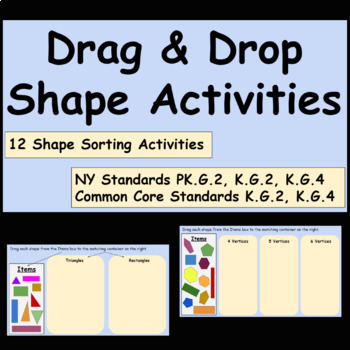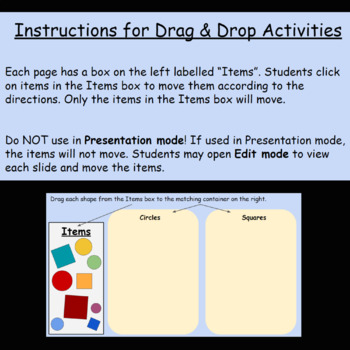Drag & Drop Shape Activities - Google Slides Shape Sorts - Distance Learning
Schooling Anywhere by Stacy Uptagrafft
323 Followers
Resource Type
Standards
CCSSK.G.A.2
CCSSK.G.B.4
Formats Included
- Google Slides™
Pages
14 pages
Schooling Anywhere by Stacy Uptagrafft
323 Followers

Made for Google Drive™
This resource can be used by students on Google Drive or Google Classroom. To access this resource, you’ll need to allow TPT to add it to your Google Drive. See our FAQ and Privacy Policy for more information.
Description
This digital resource includes 12 shape sorting activities for preschool, kindergarten, or first grade students to classify shapes by name, sides, and vertices. **Do NOT use in Presentation mode! Students must use in Edit mode to move the items.** Only the shapes will move on each slide! These activities are perfect for students of any age to practice classifying 2-D shapes including circles, triangles, rectangles, ovals, hexagons, pentagons, squares, and rhombuses.
Vocabulary used: shapes, sides, vertices, shape names.
Standards: NY-PK.G.2, NY-K.G.2, NY-K.G.4, CCSS.Math.Content.K.G.A.2, CCSS.Math.Content.K.G.B.4.
Check out my other digital resources:
Total Pages
14 pages
Answer Key
Not Included
Teaching Duration
N/A
Report this resource to TPT
Reported resources will be reviewed by our team. Report this resource to let us know if this resource violates TPT’s content guidelines.
Standards
to see state-specific standards (only available in the US).
CCSSK.G.A.2
Correctly name shapes regardless of their orientations or overall size.
CCSSK.G.B.4
Analyze and compare two- and three-dimensional shapes, in different sizes and orientations, using informal language to describe their similarities, differences, parts (e.g., number of sides and vertices/“corners”) and other attributes (e.g., having sides of equal length).



